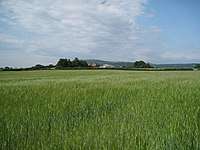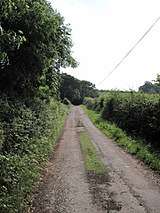Hope Hall
Hope Hall, Hope, Flintshire, Wales was a country house, built in 1740 and demolished in 1960.
The building

Hope Hall was built on the site of am old farm house and building.[1] The Hall was described as being an imposing building, two and a half stories high, constructed of red coloured handmade brick building with stone features.[1] There was a small brickyard at Hope Hall for the purpose of making bricks solely for the maintenance of the estate building. The bricks were made by machine and name stamped ' Hope Hall'. The precise dates that the brickyard were in operation is unknown, although on a map dated 1871 shows a shed and a small claypit at the Hall.[2]
On 8 October 1867 a fire destroyed an outbuilding and its contents, valued at £150.[3] On Sunday, 10 August 1878, the wife of the Reverend Robert Roberts was in the house when it was struck by lightning damaging a chimney pot.[4] The hall was demolished in 1960.[1]
History

Differing accounts exist about the origins of Hope Hall. Written was that in 1740 a brick built house was constructed on the site of old farmhouse and buildings that were held by the Longueville family from the reign of King Henry VI (1422-61). It was built for Elizabeth Charlotte, the daughter of Sir Thomas Longueville of Esclusham Hall, Rhostyllyn.[1] An alternative version is that the brick house replaced an older farm on the site in 1751. Sir George Wynne, due to family debts, sold their Broughton Hall estate, and to save money built the new hall. In 1791, a £30,000 debt led to them mortgaging the estate to the Brooke family.[5]
In 1791, when the village of Hope was enclosed, the Reverend J. Hope Wynne-Eyton possessed the lands of Hope Hall.[5] In 1815, Hope Hall was the seat of Sir Richard Brooke, 6th Baronet of Norton Priory (1785-1865), the High Sheriff of Flintshire.[6][7] In 1826, it was the seat of John Price the High Sheriff of Flintshire.[8] In 1868, it was in the possession of Thomas Wynne-Eyton, as part of the Leeswood Estates. The Eytons of Hope Hall were descended from Kindick Efell, Lord of Esglwyseg, and Madog, Lord of Leeswood.[9]
Tenants
1861 John Lloyd, a farmer [10]
1871 Joseph Dutton, a farmer[11]
1881 John Greenwood, a farm bailiff[12]
After 1891 until at least 1911 a farmer [13][14][15]
See also
References
- 1921-, Lowe, Raymond (2002). Lost houses in & around Wrexham. Ashbourne: Landmark Pub. ISBN 1843060574. OCLC 50999416.CS1 maint: numeric names: authors list (link)
- 1956-, Connolly, Andrew (2003). Life in the Victorian brickyards of Flintshire and Denbighshire. Llanrwst: Gwasg Carreg Gwalch. ISBN 0863818927. OCLC 56137288.CS1 maint: numeric names: authors list (link)
- "Fire at Hope Hall". George Bayley. 12 October 1867. hdl:10107/4582795. Cite journal requires
|journal=(help) - "Thunderstorm - Providential Escape". George Bayley. 10 August 1878. hdl:10107/4578777. Cite journal requires
|journal=(help) - Evans, D.G (1983–1984). "The Hope Enclosure Act of 1791". Flintshire Historical Society Journal. 31: 1983–1984 – via The National Library of Wales.
- "Sir Richard Brooke, 6th Baronet". www.thepeerage.com. Retrieved 11 May 2018.
- The New Annual Register, Or, General Repository of History, Politics, and Literature for the Year ... G.G.J. and J. Robinson. 1816.
- The Annual Register, Or, A View of the History, Politics, and Literature for the Year ... J. Dodsley. 1827.
- "MAJORITY OF THE HEIR OF LEESWOOD". newspapers.library.wales. Retrieved 14 May 2018.
- "1861 England, Wales & Scotland Census". Find My Past. Retrieved 11 May 2018.
- "1871 England, Wales & Scotland Census". Find My Past. Retrieved 11 May 2018.
- "1881 England, Wales & Scotland Census". Find My Past. Retrieved 11 May 2018.
- "1891 England, Wales & Scotland Census". Find My Past. Retrieved 11 May 2018.
- "1901 England, Wales & Scotland Census". Find My Past. Retrieved 11 May 2018.
- "1911 England, Wales & Scotland Census". Find My Past. Retrieved 11 May 2018.